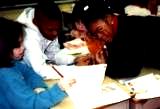“Every success is built on the ability to do better than good enough.”
I’m beginning to understand Tabor Rotation, but what are readiness groups and why are they important?
The Tabor Rotation Framework asks teachers to flexibly group students in a variety of ways. Each week includes partner work, whole-group instruction, teachable moments with individual students, small group work with students of mixed abilities, and working with small groups of students who are grouped together according to their level of understanding of the concepts that are being explored that week.
Students are grouped heterogeneously for the rotation through the four stations on Days 2 & 3 of the Tabor Rotation Framework. This type of grouping promotes the communication between students in the group and between the teacher and the students. If students who are at-promise in general ability in mathematics sit between a couple of other students who have a little bit greater ability, then the teacher/leader/co-leader isn’t the only person in the group who can explain or clarify how to process a concept. This varied perspective gives students a chance to learn from each other at the other stations.
Just as important is the homogeneous grouping of students on the continuum of readiness for the concepts that are being explored that week. The students’ placement on the continuum is determined by pre-assessments, curriculum compacting, informal assessments, formative assessments, and clipboard cruising. Readiness grouping takes place on Thursdays and Fridays. After Vivid Vocabulary and the Whole-Group Mini-Lesson, all students are involved in an application of a simple or previously learned concept. Sometimes teachers use a tiered Application Menu of Concepts to engage all learners in an appropriately differentiated practice. As all students are working, the teacher uses the information gathered during the week to pull readiness groups.
On Days 4 & 5 of Tabor Rotation, the first readiness group called is the “Above-Level” Group. These students have mastered the week’s concepts at an abstract level and are ready to be qualitatively challenged with different work. The teacher meets with these students for 8-10 minutes and sends them back to work on the tiered assignments or on a different set of assignments designed to challenge their deepened level of understanding.
Next, the teacher meets with the “On-Level” Readiness Group for 8-10 minutes. Why meet with them? They are on level and have a basic level of understanding of the week’s concepts. Here’s why…if a teacher will meet with these students and build on their interests and learning styles to challenge them, they will become highly able learners. Typically, these students are never met with at all because the perception of a district is that these students will “pass” so they are just fine. I believe these “woodwork” students are the untapped gold mine of a school. We have no idea what they could do with a little bit of individualized attention, because they have rarely received individualized attention.
The last readiness group called is the “Approaching-Level” or “At-Promise” students. These students have not mastered all of the concepts for the week even though they experienced the concepts in varied modalities and met with the teacher in Teacher Time. The students are given a different experience with the week’s concepts so they may continue on their way to mastery.
Why use mixed grouping at the Tabor Rotation Stations? Why keep a constant check on students to determine their level of understanding & form readiness groups…because…ALL students deserve qualitatively challenging, respectful, and meaningful work. ALL students need time to meet with the teacher in a small group setting and receive additional and appropriate assistance. Varying the grouping is a great way to make sure this occurs!
“The greatest danger a team faces isn’t that it won’t become successful, but that it will, and then cease to improve.” -Mark Sanborn
“Success always comes when preparation meets opportunity.” -Henry Hartman


